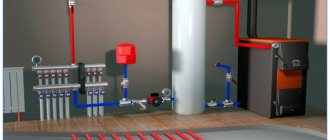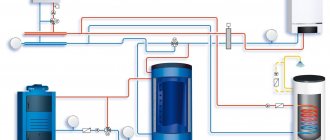Due to the constant increase in prices for utilities and space heating, the problem of finding a rational type of autonomous heating is becoming increasingly important. A variety of systems have been developed and are successfully used, each having their own distinctive features, advantages and disadvantages. One of the most promising systems is gas convectors. Let's try to figure out in what cases their installation is recommended, what types of such devices are and how they work.
Flaws
All of the above belongs to the category of advantages of gas convectors. Next we will look at the shortcomings. All pros and cons are such only in the context of this article. For example, if we take the speed of acceleration of a car, then high engine power can be considered a plus, and driver safety and fuel efficiency can be considered a minus.
This is the case with gas convectors. The biggest disadvantage of this device is that you need to drill into the wall to install it. And not just make a hole, but a hole for a coaxial gas outlet. The gas outlet is a special tube in a pipe through which exhaust gases exit, and the fresh air necessary for combustion enters the convector through an external pipe. It is logical to assume that there should be a hole in the wall in the place where the convector is located, and if they are located under every window in every room, imagine how many holes there will be in your house! And these holes cannot be hidden or brought to one place. And remember another hole in the wall for gas supply. A vivid picture of a house appears before your eyes, shrouded in gas pipes and full of holes in the walls. Agree, not a very inspiring sight!
Let's imagine a living room with an area of 30 square meters with two windows. Using a standard heating system, a convector would need to be placed under each window. In the case of gas convectors, this option does not work. We will need to install one convector with increased power in a certain place on the external wall of the room, where there would be optimal conditions for supplying gas there and making a duct for exhaust gases. With this installation there will be no temperature balance in the room. It will be hot in one corner and cold in the opposite. For comfort, you need to place another low-power convector under each window, which immediately doubles the cost of the entire system and the aesthetics of the room. We conclude that this option is inferior to a conventional water heating system.
The gas convector has low inertia. In other words, it heats up very quickly and cools down at the same speed, which can be considered both a plus and a minus, it all depends on how the device is used. In a residential area, of course, this negatively affects the comfort of the temperature regime, but for a garage, workshop or shed, quick heating is a definite plus.
There is one more nuance in a gas convector, which can, in a certain case, be considered a plus or a minus. It has a combustion chamber in which the gas, burning, heats a certain body and a chamber, which then heats the air. For a long service life of the convector, it must use steel that is resistant to fading. It’s good if it uses just such a special steel. But in this case it will not be cheap at all. If it uses cheap steel, then the convector will very quickly fail due to corrosion, burnout, etc. Now, if in a convector the combustion chamber is made of 10 mm cast iron, then such a device will practically last forever.
Preparing for insulation
Before insulating the balcony, first study the condition of the parapet. To arrange a full-fledged room, it is first strengthened. Then modern double-glazed windows are installed. Additionally, they do waterproofing work and insulate the room.
To insulate the walls, they are laid out with bricks or foam blocks. Glazing can be done immediately after this
To improve thermal insulation, you need to install high-quality double-glazed windows with a profile of at least three chambers. Important! It is best to entrust the work with glazing to professionals. They will assess the condition of the balcony, take measurements and do all the work
All gaps between the parapet and the floor, as well as in the walls, are properly sealed, filled with construction foam or sealant. Protection from moisture is carried out using coating or roll waterproofing. After this, the walls and floor are sheathed with foam plastic, mineral wool or extruded polystyrene foam to reduce heat loss.
Design and principle of operation of a gas convector
How does a regular water convector work? This is the most common steel, cast iron, aluminum or bimetallic radiator connected to the heating system. Hot coolant enters the convector, after which the equipment begins to heat the atmospheric air. An electric convector works in approximately the same way, only instead of a coolant, electricity is supplied here, not through pipes, but through wires.
Gas convector device.
How does a gas convector work and what is this unusual device? A heating gas convector is an autonomous heating device that generates heat through a built-in gas burner. The resulting heat is released into the atmosphere, as a result of which the room is heated. But these convectors cannot be called completely autonomous - after all, they can also operate from main gas. Another thing is that such heating does not require laying pipes with coolant and installing a gas boiler.
Gas convectors for heating have a relatively simple design. Inside we will find:
- gas burner;
- closed (less often open) combustion chamber;
- heating control circuit;
- air heat exchanger;
- security systems.
All this is dressed in a pleasant-looking case. The equipment turns out to be compact, but a little bulky - after all, inside there is a full-fledged gas burner and an impressive heat exchanger.
The air heated in the heat exchanger tends upward, and cold air fills its place.
The operating principle of a gas convector is very simple - natural or liquefied gas enters the burner, ignites and heats the finned heat exchanger, and the combustion products are removed outside using a fan. When heated, the air rises and enters the room. It is replaced by colder air masses. Continuous convection is created, in which almost all the air in the room takes part.
The operation of the burner is controlled by a thermostat that analyzes the air temperature in the room. It is he who turns the gas burner on or off, maintaining the set temperature.
These devices are used to heat buildings for various purposes - these can be residential premises, small offices, utility rooms and much more. Compact gas convectors for dachas are also produced, with minimal dimensions and designed for heating small rooms. A common feature of all such convectors is that they heat the air in only one room - if you need to heat two or three rooms, you will have to buy two or three convectors.
Organization of the heating system
Depending on the power, all inverter boilers can be divided into the following types:
- Industrial. They have large dimensions, a rather complex current conversion system (carried out by an inverter for a heating boiler), and volumetric heat exchangers.
- Household. This type of model is characterized by relatively small dimensions, as well as the ability to operate on mains power or batteries.
When the boiler is operating, the overall load in the electrical network of the premises will increase, so the wiring will need to be laid with a larger cross-section.
An important aspect is the safety of the boiler. And this nuance must be properly ensured. So, you will need to install a protective electrical unit that will automatically de-energize the boiler if there are voltage drops in the network.
Installation recommendations
It is well known that the installation of a gas convector consuming main methane must be carried out by specialists from companies that have the appropriate permits. It is worth clarifying this somewhat generalized requirement: the issue is not installation, but connection to the gas supply network. This operation can indeed be performed by the above-mentioned workers in accordance with previously completed project documentation. This means that you can put the units in place with your own hands, but without connecting to the gas pipeline.
If you nevertheless decide to take bottled gas as an energy carrier, then the situation is simpler. Connecting propane heaters does not require any permits. However, it is strongly recommended to involve a specialist in this work, at least as a consultant. It will help you check the correctness and quality of the connections and carry out the first start-up of the unit.
Before installing a gas convector, you need to make a round hole of the appropriate diameter in the wall. Next, attach the device to the wall or floor according to the operating instructions. In this case, in some heater models, the external temperature sensor with a capillary tube must be moved from the transport position to the working position. After this, all that remains is to connect the fuel supply line to the inlet pipe on the device.
Self-transfer of batteries tools, materials, instructions
Installing a battery on your own on a balcony or loggia is a rather difficult task that requires certain skills and abilities. Therefore, in this case, it is much more rational and practical to invite a professional plumber to perform this work.
If you plan to cope with such a rework on your own, first, you will need to stock up on the appropriate materials and tools.
In addition to the radiator itself, you will also need a set of plumbing fixtures, including:
- Mayevsky crane;
- Shut-off and control valves;
- Plugs and foot nuts;
- Pipes;
- Fitting;
- Bulgarian;
- Hammer;
- Vise and die;
- Roulette;
- Welding apparatus;
- Sealant.
Before installing heating on the loggia, you need to decide which connection scheme will be used. In this case, it is better to use the option with a jumper, as it will allow you to perform any operations with the radiator both in winter and in summer, without causing inconvenience to others.
Getting started with the main work, follow the instructions:
1. We make a connection to the main pipe. For this purpose, using a grinder, we make a small cut, cut the external threads on the pipes and fasten them with a fitting that has an additional branch.
An important point of this stage: waterproofing of all connections, for which you can use tow or modern fum tape.
2. Through the holes cut in the wall, we pass pipes with external threads applied to them on both sides so that they extend approximately 8-9 cm. At the second end of the pipe we attach an angle fitting so that it “looks” vertically.
3. We hang the radiator. To do this, you need to first mark the fixation points and install brackets (for cast iron - anchored or reinforced), drilling the wall using a hammer drill and securing them to a previously prepared wall that has been fully finished using wallpaper, decorative paint or plaster.
4. We fasten the radiator by placing rubber washers between the battery parts and brackets.
5. We adjust its location using a building level.
6. We connect the eyeliner. From the radiator we produce two pipes 25-30 cm long, one end of which will be connected to the battery, and the other will be closed with an angle-type fitting.
7. We proceed to the installation of vertical pipes that serve to supply and drain water from the radiator. They need to be screwed into the finished fittings, making sure to seal all connections.
Some tips:
- To take the battery to the balcony and secure it there, use 2 brackets at the top and one at the bottom.
- Place the radiator at a distance of no closer than 2-4 centimeters from the wall, 10 centimeters from the window sill and 12 centimeters from the floor.
- Place a foil heat-reflecting screen on the wall behind the radiator.
- It is advisable to use plastic polypropylene pipes that are connected to fittings by soldering.
Carrying out work on installing a battery on a loggia requires great care and attention. This is especially true for the quality of welding and sealing of all connections, on which all subsequent operation of the system depends.
This video shows detailed instructions on how to remove the battery to the balcony with your own hands.
How to turn on a gas convector
Again, it is recommended to entrust the first start-up of the unit to a specialist. After he has completed the commissioning work, you can safely use the equipment yourself. The algorithm for turning on the convector is as follows:
- check the presence of draft, and then open the gas valve at the inlet of the heater;
- press and hold the adjustment knob on the valve;
- use the piezo ignition button to light the igniter;
- hold the handle for 10-15 seconds, then release;
- If the wick does not go out, slowly turn the handle and set the desired temperature. The main burner will light up automatically.
If your convector is equipped with a blower fan, a supercharger and electric ignition from batteries, then it starts automatically. You just need to plug in the device, open the gas tap and press the corresponding button on the front panel.
What gas is used
In the original version, the convectors were designed to consume mains gas, which created a false assumption that the installation used only natural gas.
But when using special transition kits, it is very easy to convert it to liquefied fuel. Some device models are already designed for the possibility of transition.
The use of bottled gas has several nuances, including:
- It is economically inefficient to work on liquefied fuel, since the cost is equal to the price of electricity if correctly recalculated.
- There are strict requirements for the installation and operation of equipment. It is better not to deal with the installation process yourself, but to entrust the arrangement to specialists.
Gas convectors technical characteristics or what they are
Essentially, we have before us a simple heating device consisting of a heat exchanger in an attractive housing and a gas burner.
Construction of a gas heating battery
An excursion into history: back in the 19th century, rooms were heated and illuminated with gas, and even in those days this heating method was cheap, convenient and practical. But then the heating systems and lighting ran on acetylene and were ordinary gas jets, i.e. open burners. Such burners required adjustment to minimize the volume of soot. In addition, combustion products exited the room through a common single ventilation. At the same time, oxygen was consumed to maintain combustion from the volume of the room.
Gas heating convectors have several pleasant innovations, which, ultimately, make them modern heating batteries from rarities:
- The gas flow rate is automatically adjusted, which means more economical gas consumption. A simple thermostat turns off the burner or switches it to maintain the flame when the required temperature is reached. If it becomes 3° less, then the fire lights up again.
- The flame heats the heat exchanger, and not the actual air in the room.
- For most models of modern gas heaters (convectors), air to support combustion comes from the street. And combustion products are removed there too. In this case, it is not a fan that is used, but a pipe in a pipe, the so-called. “coaxial duct”, which is discharged through a different opening.
These are closed-type gas heating convectors. However, there are also so-called open-type gas heating batteries that take air from the room and discharge combustion products into the general ventilation system. Such gas convectors are in great demand due to their easy installation: for heating you just need to connect the battery to the gas source.
Open type gas heating appliance
Fuel for operating a gas heating appliance
You should not think that gas heating radiators can only be placed in places with a natural gas supply from the main gas pipeline. In essence, the operating principle of a gas convector is to use such gas. But manufacturers also produce special adapters that allow the gas convector to operate on liquefied gas, i.e. connect the heating device to a regular cylinder.
Gas convectors using natural gas
Features of a gas heating convector: pros and cons
How convenient and profitable is heating with a gas battery? Does it have any disadvantages? First, let's look at their advantages:
- The cheapest way to heat both an apartment and a house. However, if gas convectors using bottled gas are used, heating costs are almost equal to those of an electric boiler. And less profitable than a solid fuel boiler or heat pump.
- The efficiency of such heating devices can reach up to 97%, i.e. they are economical.
- They can operate at any temperature, even at -50°C.
- There is no combustion of oxygen in the air of the room. Since air is used for combustion, which comes from outside the house.
- Service life - at least 20 years.
- Installation of a gas convector is simple and can be done with your own hands. See below for more details.
- Autonomy: you can easily heat several rooms of the house or just one room.
As with the operation of any gas equipment, batteries (convectors) must be used in compliance with strict safety measures, since the gas is explosive!
When using gas convectors using bottled gas, the saving effect from using such heating batteries is reduced to zero. Gas batteries are only useful when there is no electricity. At the same time, the process of replacing the cylinder with an interval of 1 to 4 days may seem quite tedious.
More cons:
- Gas radiator heating cannot be used to heat water.
- Quite limited thermal conductivity - 2-7 kW (for most models).
- Despite their rather beautiful appearance, they are quite large in size, so they are not easy to disguise.
- Since this equipment runs on gas, its installation and connection requires obtaining permission from a special gas service.
Balcony heating methods
To heat a balcony or loggia, you can use several methods:
- Remove central heating.
- Organize a heated floor system.
- Use infrared or electric heaters.
- Install oil radiators.
Central heating
Centralized heating on the loggia will require separate permission from local governments and the technical inventory bureau. In most large cities, using this method of heating balconies is prohibited. The reasons for the ban are a decrease in the temperature of the coolant that reaches the upper floors, as well as a possible pipe rupture in the event of critical temperature drops. To obtain permission to take out, the written consent of all residents and full annexation of the premises will be required.
How can you install heating on a loggia? After receiving permission, you can begin installation. It is worth considering the following points:
- To reflect heat, it is worth covering the wall behind the radiator with foil or other material with similar properties.
- After which you need to completely shut down the heating system. To do this, you need to call a locksmith from the housing office.
- After circulation stops, you need to drill holes for the pipeline. A special hose is used to transfer fluid, to which a tee is then attached.
- Then you need to attach the radiators to the wall. You need to install two brackets into the wall at the top and one at the bottom.
- After that, connect the branch to the main system.
Warm floor
How to make heating? If the use of centralized heating turns out to be ineffective, then a “warm floor” system can be used. From the tubes laid on the floor, heat will rise to the top, which will allow you to constantly maintain comfortable living conditions.
Warm floor
There are two main types of heated floors:
- Electric;
- Water.
To install the water version you will need:
- Lay a concrete screed.
- Then completely level the base.
- Attach thermal insulation material so that the energy from the heated floor does not go down. Foil materials work well.
- After which, a network of hollow pipes is laid out in a serpentine pattern to cover as large an area as possible. After which the pipes are connected to centralized heating.
- Then it is covered with a decorative floor covering.
Compared to analogues, this type of heated floor is relatively difficult to install.
To install the electric version you will need:
- Apply cement-sand screed up to 50mm thick.
- Then, attach a layer of thermal insulation.
- Place the cable on the floor in the form of a snake or serpentine.
- Attach decorative covering. Moreover, it is advisable to choose a coating that transmits heat well.
Infrared heater
How to heat a balcony with electricity? Infrared heaters are well suited for this. They transfer heat to surfaces, which then release it into the air. The main advantages of such equipment include:
- Low energy costs;
- Availability;
- High room heating rate.
Electric heater
One of the popular ways to heat a balcony is to use electric heaters. Their advantages include:
- High heating speed;
- The presence of thermostats to maintain a stable temperature;
- Availability.
Among the disadvantages are:
- High energy consumption;
- Fire hazard.
Oil radiators
Oil radiators are also suitable for heating balconies and loggias. They will also require conducting electrical energy to the balcony. The advantages of the heating method include:
- Mobility. They are equipped with transport feet or wheels, making them easy to move.
- Low energy costs due to cyclic operation.
- All devices have a built-in thermostat that will maintain a constant temperature.
- All devices of this type are safe for health. Sections do not heat above 60 degrees. In case of excessive heating, an emergency shutdown system is activated.
The disadvantages include:
- Low heating speed.
- A large mass of devices. Weight can reach 30 kg.
With relatively low heating of the premises, they retain heat for a long time. Therefore, their use is a good option for long-term stays on the balcony.
Oil radiator
Construction of gas convectors
Let's consider the device of a gas convector. 1. Body. Provides device protection. Usually made of durable metal and coated with a special protective paint, which is resistant to temperature changes and protects the body from corrosion. 2. Heat exchanger. The task of this structural element is to heat the maximum amount of air as quickly as possible. For these purposes, the heat exchanger is made finned. Due to constant contact with gas, it is mounted from high-strength steel or cast iron and is also coated with high-temperature paint. 3. Gas burner. It is located inside the housing and consists of a pilot burner to which an electrode is attached to ignite the gas using a discharge. After this, the main burner is ignited. 4. Smoke exhaust system. There are open and closed types. 5.Thermostat. When the room air is heated to a predetermined temperature, the thermostat is activated and the gas supply is at the minimum level required only to maintain the desired temperature. 6. Automation system. Responsible for safety and at the first problems in the operation of the convector, it instantly turns off the device.
Different sizes of convectors
Device
Gas convector operation diagram
The design of the gas convector is extremely simple, it contains:
- the combustion chamber;
- gas-burner;
- automation unit (Eurosit);
- a heat exchanger that forms the outer part of the combustion chamber;
- coaxial chimney.
The combustion chamber is of a closed type. Air from the street is supplied into it and combustion products are discharged there. There are a small number of models of convectors with an open burner, but it is better to avoid such devices, as they quickly burn oxygen into the room and saturate the air with CO2 and other combustion products.
Combustion chamber and heat exchanger material:
- steel;
- cast iron.
A steel camera is lighter and cheaper. A convector with a steel filling is 10-15 kg less in weight than with cast iron. However, even if the manufacturer used special heat-resistant steel, it still burns out over time and the service life of such a device is lower.
The cast iron combustion chamber has an almost unlimited service life; it is sensitive only to sudden temperature changes. What causes microcracks in the material. Otherwise, cast iron is resistant to corrosion, does not thin out under the influence of open fire and has a high heat capacity, which is rather a positive characteristic for a heating device.
The convector uses a simple-shaped single-module burner that ensures even combustion over a distributed area
It is important that the flame on each nozzle is small, and the gas mixed with air in a certain proportion burns completely without residue
Gas convectors are designed for the use of natural gas in accordance with GOST 5542 low pressure 1274 Pa. Often convectors simultaneously support the installation of a liquefied gas cylinder, which is supplied through a nozzle and a reducer. Mechanical automation, more often the well-proven EuroSit, is responsible for controlling the gas supply, adjusting the output power and controlling the temperature in the room.
The chimney is presented in the form of a coaxial pipe, in which a pipe of a smaller diameter is inserted into a pipe of a larger diameter, forming two separate channels. Combustion products are discharged through the internal channel, and fresh air from the street enters through the gap between the pipes to maintain gas combustion. It is assumed that the convector is installed near the wall bordering the street. The chimney immediately exits to the outside of the building through a prepared channel. The shorter the chimney length, the better.
Supercharged
Heating of the heat exchanger occurs quickly and actively, its temperature can reach 600°C, although more often the heat exchanger area is designed so that the convection flow is sufficient to maintain a much lower temperature of 60-120°C.
One of the options to actively and quickly remove heat from the heat exchanger, and at the same time quickly warm up the heated room, is to use a supercharger, a fan that can quickly drive a large volume of air through the convector.
This approach is appropriate, for example, for heating a utility room, industrial or construction area, country house or garage. Where it is mostly cold, and it is necessary, if necessary, to quickly create comfortable conditions for people. If the convector is used as the main heat source, the fan will be partially occupied only at the beginning of the process, until the air is heated, and then it will turn off and not be used.
Separately, the most compact convectors should be mentioned. They use a fan constantly. The heat exchanger area is reduced to reduce the weight and dimensions of the device, and to achieve the required thermal power, a fan is needed to have time to remove heat from the combustion chamber.
Installation Rules
Once the convector has been purchased, it can be installed. Before you do this, you will need to have a certain set of tools:
- drill;
- spatula;
- pipe cutter;
- wrenches and adjustable wrench;
- screwdrivers;
- perforator;
- gas tap;
- special silicone;
- self-tapping screws;
- dowels
It is necessary to choose a place where it will be located. It is best to do this in accordance with GOST. According to it, installation must be carried out under a window. After this, you should prepare the room. That is, the surrounding space around the installation site must be covered. The installation is done according to this algorithm.
- It is necessary to determine the hole for the gas pipe to enter. It is necessary to leave a gap for the pipe and fitting.
- We make a through hole according to the size of the exhaust pipe using a hammer drill.
- We make holes for the fasteners on which the heater will be mounted, and hammer the dowels in there.
- We connect the device to the exhaust pipe and seal the joint with special silicone.
- We fix the heater to the wall using self-tapping screws.
- We seal all holes using foam to prevent cold air from entering the room.
pros
Economic indicator. Electric convectors are cheaper. But a special advantage of gas convectors is their reduced operating cost. For example, popular models with cast iron heat exchangers and a power of up to 3 kW cost twice as much as electric ones with similar parameters.
However, this difference is very quickly covered during operation. The fact is that, according to calculations, the cost of heating the same area of a room when using natural gas is sometimes 10 times lower than when using electricity. The price of a cubic meter of gas and a kilowatt of electricity are approximately similar. But savings are achieved due to the fact that only 0.1 m3 of gas is needed to produce 1 kW of thermal power. All these statements are valid only when a gas convector is connected to a main pipeline and natural gas is used.
Work on liquefied gas. A gas convector can be easily converted to bottled gas. This makes it possible to use such heating devices in areas where there is no electricity or where it is supplied intermittently. But from an economic point of view, convectors using liquefied (cylinder) gas are also economically imperfect, like electric ones.
Lack of coolant. This is a noticeable plus in the absence of running water in the rooms where heating devices are planned to be connected. This is also an excellent factor if during the frosty season you need to leave the building for a long time - the water in the convector will not freeze, since there is none there. This is a good option, for example, for cottages, garages, utility rooms.
Environmental friendliness. The gas convector does not burn oxygen and is safe if all operating standards are observed.
Temperature adjustment. Such convectors have the full possibility of easily setting the required temperature and adjusting it.
Types of devices
A gas air heater, like other heating equipment, is an excellent option for creating a comfortable temperature regime. Depending on the place of use, they are made in two types:
- Stationary are gas heaters using natural gas for the home; they are connected to the appropriate mains (they can also be powered by a liquefied gas cylinder); a prerequisite for installing such equipment is the presence of a chimney that ensures the removal of combustion products and the flow of air. For ease of use, models are available equipped with replaceable nozzles that provide various ways to connect the device.
- Portable devices are not able to provide full heating of a residential building or an entire apartment, so they are used in dachas, in the garage, to maintain heat in the room. Due to their mobility (small size and weight), the devices can be placed in any room and, if desired, moved to other rooms. Such heaters operate on liquefied gas (connected to a household cylinder).
In this video we will look at a gas heater and its capabilities:
For ease of placement, wall, floor and ceiling models are available. The combustion chambers also differ. The closed type of chamber is more practical to use, since the air required for combustion comes from the street and the products of work are discharged there.
Despite the variety of models produced, gas heaters have the same components. The main components of the devices are:
- Frame.
- Burner.
- Heater.
- Heat exchanger.
The most common models of gas heaters are:
- Infrared heaters are equipped with metal or ceramic emitters that, when heated, emit heat (infrared waves), which heats the objects in the room, rather than the air.
- Catalytic models are considered safe. During operation, there is no combustion process itself; the release of thermal energy occurs as a result of a chemical reaction. The fuel supplied to the catalytic panel is oxidized, resulting in the release of heat. The room is heated using both convection and infrared or mixed types.
- Convection heaters are the simplest units. As a result of gas combustion, finned radiators heat up, from which heated air rises, and cold air falls in its place and heats up.
When used correctly, these devices will be reliable assistants capable of quickly creating a comfortable thermal regime in any room, even in the absence of electrical energy.
Alpine air NGS-30F
Main characteristics:
- type – wall-mounted;
- power – 3 kW;
- heated area – 30 m²;
- Efficiency – 87%;
- heat exchanger – cast iron;
- electric fan – yes;
- dimensions (H×W×D) – 630 × 455 × 220 mm;
- weight – 22 kg;
- gas consumption – 0.32 m³/hour.
Model description
The Alpine air NGS-30F convector is a wall-mounted gas heating device based on a high-quality cast iron heat exchanger. The unit is equipped with reliable independent automation, and the device itself can be installed in regions with very low temperatures, because it is not afraid of difficult operating conditions. It can also be installed in different types of rooms. Since the convector does not require a water heating system to operate, it can be used in dachas and places of temporary residence.
A special feature of this model is the presence of an electric fan for forced convection, which is started by pressing one button. With the help of a fan, the room warms up faster, and you can also heat a larger area of the building. This unit requires a power supply, and the piezo ignition works without a battery.
The closed combustion chamber allows the equipment to be used with closed windows and poor ventilation. The operating principle is to heat the air, not the coolant, so the efficiency remains high. Manufacturers have not forgotten about safety, having equipped the device with a telescopic coaxial pipe to remove exhaust gases and supply clean air, so you don’t have to worry about installing a chimney. All you need is to ensure that the pipe goes outside and connects to a gas system or a liquefied gas cylinder.
Advantages and disadvantages of the device
The main advantage of the Alpine air NGS-30F gas convector is that it does not require any additional maintenance and can remain on for a long time. Unlike a boiler heating system, this heater is not afraid of freezing. Thanks to the closed type of combustion, the open fire and the entire combustion chamber remain completely isolated, which means that toxic waste products will not enter the air and there will be no need to provide additional air flow from the outside into the heated room.
The model is equipped with a cast iron heat exchanger, which has a significant service life, and a proprietary POLIDORO pilot burner. The set temperature is maintained using a SIT Eurosit 630 thermostat.
As in the two previous cases, thanks to the coaxial telescopic pipe, the outlet and influx of fresh air passes along its outer and inner sides without mixing with each other. It is impossible not to note the modern design of the device and its compact size, which adds to the popularity of this model of convectors.
Flaws
The price of the device is higher than that of analogues with a steel heat exchanger. This is a rather bulky device with considerable weight.
Internal layout and materials
As mentioned above, the main task of the heating system - heating the air - is solved by a heat exchanger. Therefore, the choice of its configuration, size and material of manufacture must be carried out especially carefully. In the first two points (configuration and size) there is a unity of opinion.
Thus, the most effective is the S-shaped position of the tubes in a ribbed radiator, which ensures uniform heating of the metal and rapid release of the body to the passing flow. The dimensions are set in proportion to the power of the device. Manufacturing materials are more difficult.
The buyer or system assembler will have to choose from several options, each of which has its own advantages and disadvantages.
The most popular are:
- Steel is cheap, heats up quickly, but also cools down quickly. It is susceptible to corrosion, and therefore is relatively short-lived, and gradually loses efficiency during operation.
- Cast iron is another budget solution, but more promising than steel. Cast iron is fragile, so products made from it should be installed carefully, and the large specific gravity of the material imposes additional requirements on the reliability of mounting the system on the wall. Among the advantages of cast iron is its high heat capacity, that is, the ability to release accumulated heat for a long time even after the burner is turned off.
- Aluminum alloys – due to their low weight, high strength and chemical stability, are capable of functioning reliably for a long time. In terms of heat capacity, they are practically not inferior to cast iron, but they are an order of magnitude more expensive.
- Copper – provides maximum heat capacity, is practically not subject to corrosion, can withstand temperature and pressure changes well, and is easy to mold and install. However, you will have to pay well for such versatility - copper heat exchangers are the most expensive offered on the modern market.
Having analyzed the advantages and disadvantages of each material, we can come to the conclusion that in industrial gas convectors, heat exchangers made of cast iron and aluminum alloys are preferred, since they provide the optimal price-quality ratio.
In home-made devices, it is better to give preference to aluminum alloys or copper as they are more reliable and not so demanding on the skills of the assembler.
Another dilemma to be solved is whether the system is equipped with an open or closed combustion chamber.
- The open chamber takes cold air directly from the room, warming it up and removing combustion products into the external environment. However, if there is an installation error, an insufficiently efficient exhaust hood, or in a poorly ventilated room, there may be a lack of oxygen and an increase in the concentration of carbon monoxide. It is recommended to install a convector with an open combustion chamber exclusively in non-residential premises.
- The closed chamber forces atmospheric air inside through a coaxial pipeline. Combustion products move along it in the opposite direction, which preheat the clean air through the pipeline wall. This system is more reliable and safer, it is compact and easy to install. However, a closed chamber is not without certain disadvantages - its operation requires electricity, which is not always convenient in suburban conditions, in addition, the price of a convector with a closed burner is always higher.
And the last feature, which was already mentioned above, is the presence of a fan heater. Everything is simple here - the more powerful the fan, the faster the heated air will reach remote rooms and walls, ensuring a more uniform distribution of heat. And as the fan power increases, the noise level and electricity consumption increase. In powerful devices, the fan also prevents the heat exchanger from overheating, thereby extending its service life.
Is it possible to take the battery out onto the loggia?
In each individual region, the ban on bringing central heating into the territory of the loggia is regulated by its own documentation. But the general basis for prohibiting such redevelopment remains the same. If you remove the radiator of your own free will, you may be fined.
However, some apartment owners are trying to legalize the removal of heating to the loggia. To do this, you need to contact the management company that maintains the house. It is necessary to agree on a plan for future redevelopment with her and obtain the necessary permission.
But it is worth remembering that inserting another battery will reduce the overall pressure on the heating system, and this can lead to cooling not only of your apartment, but also of all other rooms in the house.
Features of choice
When choosing a gas convector model, you must take into account its operating conditions. Among others, the area of the room and the required temperature for heating should be highlighted. The described heating devices have additional features, including:
- circulation method;
- thermal power;
- drawing method;
- installation option;
- heat exchanger material.
As for the first factor, circulation may be absent or provided by a fan heater
Convectors can be wall-mounted or floor-mounted, sometimes this is important if the room area is limited. The heat exchanger can be based on cast iron or steel
As for the installation location, wall convectors are more practical. They take up little space and are usually installed near the window, creating a thermal curtain between the cold and warm zones. However, such devices should be quite light so as not to create additional load on the wall. Such devices are limited in thermal performance, which does not exceed 10 kW.
If it is necessary to heat a larger area, floor-standing equipment is selected, which usually has large dimensions and significant weight. The cost of wall-mounted and floor-standing units is approximately the same with similar capacities.
Battery on the balcony: heating a balcony or loggia
An insulated balcony, where the temperature remains comfortable all year round, expands the living space. A personal office, a relaxation room, a dining room and even a bedroom are set up on the balcony. A radiator on the balcony will help make the space comfortable, heating the space in the winter months. But there are certain difficulties associated with moving or installing a heating device.
Before installing the battery on the balcony space, a number of actions are performed. First, permissions are obtained for such an installation. It will be necessary to visit a number of authorities, prepare technical documentation and obtain expert opinions.
To select the right battery, calculations are carried out. Based on them, the number of sections, installation location, pressure and other parameters are planned. Do not forget that installing an additional radiator reduces the pressure in the riser. The neighbors may not be happy.
Rice. 1 How to install heating on a balcony
Before installing a heating device on a loggia or balcony, all surfaces must be properly insulated. Otherwise, the heat will escape outside, and in severe frosts the coolant may freeze and damage the pipes.
Obtaining Permits
To obtain permission to move the battery to the loggia, perform the following steps. The thermal conductivity of an insulated loggia is calculated. They conclude that the system will not freeze in winter.
They create a redevelopment project to change the status of the balcony space. It is being transferred from non-residential to residential. They receive a technical conclusion that it is possible to perform specific work. The conclusion is given by the authority that designed the house. The project is developed by licensed specialists. Design and technical documentation takes into account not only construction, but also other standards: sanitary and fire safety.
Rice. 2 How to make heating on a loggia
Issuing permits to remove batteries onto the balcony is not always possible. Sometimes redevelopment can pose a threat to the condition of the house. In some localities, the removal of central heating radiators onto balconies may be prohibited without exception.
The process of obtaining permits is lengthy and some owners have a desire to move the radiator without obtaining the necessary documents. It is worth considering that plumbers will not carry out moving work if there are no permitting documents.
Sometimes owners do not know why it is illegal to remove the battery. As a result of incorrect actions, damage to the entire heating system is caused. You won't be surprised that the battery doesn't heat up.
Rice. 3 To install loggia heating, insulation is required
You will be fined for unauthorized removal of batteries to the loggia. The owner of the apartment pays a fine from two to two and a half thousand rubles and undertakes to return the heating device to its place or legalize the redevelopment. If you refuse, you will be fined again. With such unauthorized redevelopment, other difficulties arise, for example, with the sale of an apartment.
Radiator installation
After receiving the necessary permits, installation work begins. There are a number of recommendations for their implementation.
It is recommended to use aluminum radiators on balconies and loggias. The choice is explained by the light weight of the products and compactness. They do not create additional load on structures and do not take up much space
Equally important is efficiency, i.e. high heat transfer rates
Rice. 4 Is it possible to put the battery on the balcony
- The required battery size and number of sections are calculated based on the area of the balcony or loggia. One aluminum section is designed for two square meters of area. If the installed radiator is bimetallic, then the figure is slightly less: one and a half meters.
- Install the batteries on the balcony on special mounting brackets. Three of them are required: two are placed at the bottom and one at the top. If the installed radiator consists of twelve sections or more, then the number of fasteners increases. Additional top fasteners will be required.
- The efficiency of the radiator depends not only on the characteristics of the device, but also on the installation features. The distance to the window opening from the top edge of the radiator and to the floor from the bottom should be at least ten centimeters. The distance between the radiator and the wall should be at least two centimeters.
- To reduce heat loss, the wall behind the radiator is covered with foil material. A screen is created that reflects heat and prevents its loss.
Nuances of installation and operation
Open type portable gas heaters are not recommended for use in bedrooms, bathrooms or hallways. Some models specify the minimum room size and mandatory ventilation requirements for heating appliances. The installation of gas equipment must comply with the state standard regarding the safety of gas installations.
Basic requirements for safe installation of a gas convector:
- It is prohibited to place devices in fire hazardous areas. The heater is placed under the window.
- The chimney pipe must be mounted externally and equipped with an outlet.
- Installation, dismantling, adjustment and commissioning of gas equipment is carried out only by certified Gorgaz specialists.
- After installation work is completed, commissioning work is carried out.
- Before the first start-up, open the gas inlet valve and check all joints on the gas line with a brush and soap solution.
- A piezo igniter is started to ignite the gas. It is possible that during the first hours of operation of the installation there will be a smell of burning oil due to the burning of the walls of the combustion chamber; in the future, the operation of the convector should be odorless.
Gas convector Hosseven HDU-5 DK
Options for connecting batteries on the balcony
- With tap and jumper. This is the best option for a loggia - all the heat goes through the radiator and there are no losses.
- Without tap with jumper. You can turn off the water in the radiator at any time if it is too hot on the balcony.
- With tap, but without jumper. Allows you not only to turn off the water, but also to remove the balcony radiator in order to clean it, re-stick the wallpaper on the loggia or change the design of the walls.
Installing heating equipment on the balcony will create a full-fledged additional room and make the house even more comfortable and warm. But before you decide to undertake such drastic construction work, be sure to weigh the pros and cons - obtaining permits and installing the radiator will take a lot of time and cost you a pretty penny. Today there are many models of removable batteries and powerful heaters, but if your choice is a traditional radiator, be patient and go for it - the results will be worth it.
Purpose
The convector is designed to run on natural gas for heating premises for various purposes. In this case, combustion occurs in a closed chamber, air is supplied from the street and combustion products are discharged there. The heat released during fuel combustion is transferred to the combustion chamber body and heat exchanger, and then to the indoor air. Due to rapid heating, the air rises, making room for colder air, maintaining an active convection process throughout the room.
A gas convector heats the air faster and more actively than its electric counterparts or, especially, converter-type radiators for a water heating system. This is due to the higher surface temperature of the heat exchanger and the increased rate of heat transfer from the combustion chamber.
A gas convector is an excellent solution in the following situations:
- The main heating of a small room or house with one or two adjacent rooms.
- As a replacement for a solid fuel stove, which was previously used to heat the house.
- For quick warming up and maintaining a comfortable temperature in the garage, utility room, or small country house.
- As an addition to the central heating system in rooms where installing a water radiator is difficult (basement and semi-basement, attic, veranda, etc.).
- For heating greenhouses.
As a replacement for main heating, a gas convector is only suitable for small houses or individual rooms. The efficiently heated area is easily calculated based on the available power models of gas convectors. Devices with a power of 2.5-6 kW are more often found on sale, less often up to 12 kW. In the first case, the convector is enough to heat a room up to 50 m2. The most powerful models are in demand only for industrial and public premises with an area of up to 100 m2.











